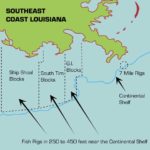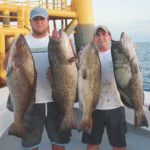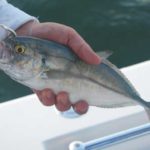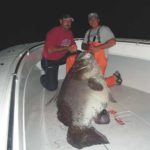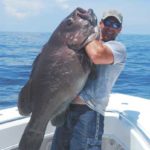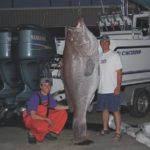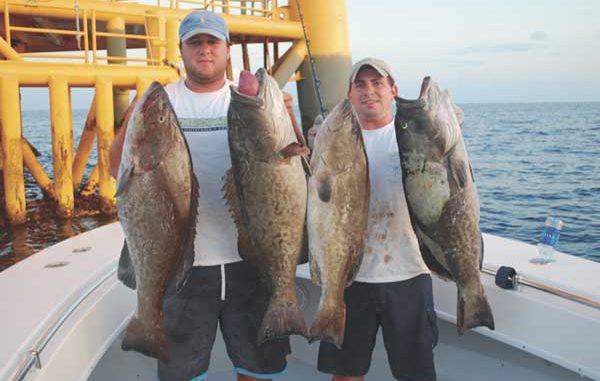
The first five seconds in a battle with a warsaw grouper will determine if you’re a record-holder like J.J. Tabor or merely a fish piercer.
It’s amazing the number of infomercials on television now that promise the impossible on an installment plan.
Want to lose weight? According to the pitchman, all you’ve got to do is take these pills, you can eat anything you want, you can lay around all you want, the fat will just magically disappear.
Want to get rich quick? Just take a gander at the fellow who is pocketing $10,000 a month selling junk nobody wants. He made $70,000 this year while he slept, and he expects to make over $150,000 next year.
Want to learn a foreign language overnight? Want a body like a Greek god? Want to “hook up” with the hottest girls in your town, who just happen to be sitting at home waiting on you to call? OK, that one doesn’t have an installment plan, but it’s beyond belief.
Here’s one for you. Want to catch giant warsaw grouper? I’m not talking about 60- or 70-pound warsaw grouper. I’m talking 300-pound warsaw grouper — maybe even one that would spin the scale all the way to 360 pounds, which, by the way, would set the new state record by 1 pound.
It’s a good thing for Louisiana sportsmen that J.J. Tabor is in residency to be a general surgeon rather than a snake-oil salesman. If he had chosen the latter, we would probably all see him late at night promising that we, too, could catch giant grouper for the low, low price of five easy payments of only $49.95.
If the name J.J. Tabor sounds familiar to you, you’ve probably been taking peaks at the Louisiana Fish Records, which are maintained by the Louisiana Outdoor Writers Association. His name is listed three times in the top eight places for warsaw grouper. Tabor currently holds spots 1, 6 and 8.
What the records don’t show, though, is that the fish that hold slots 2, 4 and 7 were caught by Ed Frekey and Mike Marcello while they were aboard Tabor’s boat. That’s some serious meat this guy is hauling in.
Get out of the warsaw grouper category, and check out the yellowedge grouper. Tabor holds the one slot. Mako shark? Tabor holds the two slot. Amberjack? Marcello holds the two slot with a 126-pound fish caught on Tabor’s boat.
The pitchmen on television may promise the impossible, but Tabor produces the impossible. However, he knows something that those pitchmen either don’t think you know or they don’t want you to know. Achieving impressive results in any endeavor is based wholly on the amount of elbow grease one puts in as opposed to the payments they make. You just can’t get something for nothing.
When asked what was the secret of his success, Tabor, who has been a part of the offshore fishing world since the tender age of 5, responded humbly if not a little secretively.
“I don’t think I fish with anything different than everybody else,” he insisted. “Most of my big fish have come on live hardtails just like everybody else fishes. I don’t think I use that much different tackle either. I strictly use 200- or 250-pound Power Pro. Some of my equipment I build myself, but I know other anglers are hooking these same size fish. They just aren’t getting them in.”
How does he know other anglers are hooking these same fish? Every big warsaw grouper Tabor has caught has come in with some kind of “jewelry” adorning its lips. Lip jewelry in this case is nothing like that loop that you hate dangling from your daughter’s lip. Lip jewelry on the big warsaws means hooks, and lots of them.
Other than Tabor, another angler who has seen the proof that lots of anglers are hooking these fish is Harahan dentist Dennis Henry, a.k.a. Dr. Grouper. The only big warsaw grouper he has landed that didn’t look like it had just left the piercing parlor is the 351-pound giant he battled recently, which now holds the No. 3 state-record slot.
“Every other big fish I’ve caught has looked like it had just come from the orthodontist,” the head captain for Mule Team Charters quipped. “They have so many hooks in their mouths they look like they have braces. I caught a 120-pound warsaw before the big one that had six hooks in him in all different colors and styles.”
If Tabor and Henry are landing these giant grouper that have obviously already left only empty memories for other anglers, what are they doing differently to get these fish in the boat?
Actually, the only thing they are doing that allows them to win the warsaw war is to win the first battle. It takes a lot of attention to detail to win that first battle, though, and both anglers live by the adage that success comes when preparation meets opportunity.
“Landing these big grouper is based more on understanding what to do when you hook up as opposed to some big secret,” Tabor said. “You’ve really got to put some heat on them early or they’ll be gone in an instant. The first few minutes — the first 50 feet — is critical. After that, you can keep pressure on him and keep him moving.”
Henry claims the warsaw window of opportunity may even be shorter than a few minutes. And there is a lot of stuff that has to go right in this short amount of time.
“What happens when a grouper hits your bait is he goes back down in the hole he just came from to hit you,” he said. “If he gets back down in that hole, you’re finished, especially a big one like these 300-pound fish. The first five seconds is the most important.”
You can’t win the first battle, though, if you can’t get a warsaw grouper to bite. And while neither Tabor nor Henry would reveal specific rig numbers, even on an easy installment plan, their advice on finding the right rigs, winning the first battle during the warsaw window and finishing the fight can help all bottom anglers turn their broken lines and broken hearts into successfully landed state-record fish.
The warsaw window
Both bottom anglers rely on 200- to 250-pound Power Pro, 400-pound monofilament, heavy weights and big circle hooks to help them quickly control the fish after it first bites. But they also both agree that winning the first battle begins with properly setting up on the rig.
“You’ve got to understand how a rig is put together,” said Tabor. “No matter what line you use, you can’t drag it across those barnacle-ridden legs and expect it to hold up. The farther away from a rig that you have to set up (based on current), the less your chances of landing a grouper.”
Tabor explained that having to set up 100 yards off the rig to try and get your bait to the bottom at the base of the rig means it has crossed so many pipes, legs and other structures that the line is going to hit something and pop once the battle begins.
“The ideal thing would be to fish with a light current,” Tabor said. “That’s the best simply because you can get closer to the rig and get your line down without having to cross so many pipes. The more current there is, the harder it is to get the fish out because you’re line is stretched out, and you have a greater chance of breaking it.”
Other than the heavy Power Pro and mono, both anglers say that using rods and reels that can stand up to the pressure of battling such large fish is extremely important. In fact, Tabor builds his own rods just for battling these big warsaw grouper. He builds them on shorter 5 1/2- to 6-foot blanks like the Seeker Stand Ups.
“The longer your rod, the more you have to hold,” Tabor said. “It comes back to simple physics. The fulcrum is at your belt, and you’re holding at a point 1 1/2 to 2 feet in front of the fulcrum. The longer the rod is, the more you have to hold at that point. And I primarily use roller guides, although I have caught some big fish with standard guides and roller tips.”
Beyond a strong rod, Henry says fishing with a two-speed reel is important because it allows him to drop the reel into the lower gear to gain more pulling power. Since there is essentially no drag involved — he keeps his drag locked down — the two-speed reel helps keep the fish coming up.
“It’s like putting your truck in low gear,” he said. “The lower the gear, the more pulling power you have. With a high-speed reel, you would stay locked up, and you couldn’t even turn the reel handle. If you’re locked up in those first five seconds, you’re going to lose the battle.”
The idea behind setting up properly and using all this heavy tackle is to get the fish away from the rig as quickly as possible. And all the line, connections and tackle have to be able to withstand the stress of pulling such a heavy fish away in a short amount of time. Any bite has to be quickly moved away from the rig because you don’t know if it’s 30 pounds or 300.
“If you’re coming back with curled line or breaks at your crimps, then that’s something you’re doing wrong at home,” Tabor said. “I break off a lot of fish, but it’s nearly always when the main line comes across something. It’s a lot of pressure on your connections, and they’ve got to hold.”
One technique that some feel is required to quickly get a warsaw grouper away from a rig is to use the boat to get it out. Tabor, who does use his boat if necessary, sees anglers sometimes trying to get their boats on plane to get the fish off the rig. That’s not always the best thing because too much tension on Power Pro will make it pop like a too-tight guitar string when it hits a rig leg.
Finish the fight
According to Tabor and Henry, the battle with a warsaw grouper is essentially over once the fish gets somewhere between 100 and 50 feet from the surface. At that point, the fish can’t control its swim bladder, and it winds up basically floating to the surface.
“Before that, you’ve got to keep the fish’s head between you and its tail,” Tabor insisted. “If you let him get his tail between you and his head, you’re done. If his head is between you and his tail, he can swim, but it’s going to be right at you rather than away from you.”
After the fish starts floating to the surface, anglers must still keep pressure on them and keep them moving, but Henry says that’s oftentimes easier said than done.
“You can hardly reel fast enough to keep up with them those last 50 feet,” he said. “They come up like a life raft. When that 351 I caught came up, he breached like a submarine. The fish was 5 feet long, and his orange stomach blew through his mouth. That thing scared the hell out of me when it came up. It looked like somebody had launched a missile. He cleared the water by 5 feet.”
It’s no wonder so few anglers can land these giant warsaw grouper. There’s a lot that has to go right in such a short amount of time. Tabor and Henry have perfected the art and science of landing these fish as proven by their domination in the record books.
However, there aren’t any shortcuts to catching fish like they have caught. It takes years of on-the-water experience.
Now, where did I see that ad promising an MD degree in only six short months?
Contact Capt. Dennis Henry at www.muleteamcharters.com or 504-858-0965.
